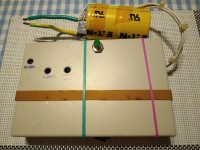Portable Spot Welding Device with Supercapacitor

For battery assembly, a spot welding tool is nice to have. I develop this portable version, using a super capacitor and recharged with standard 18650 battery
It is long time I was thinking to do a simple spot welding tool. Making normal soldering when assembly battery is often creating mechanical and thickness issue.
We can find many litterature about DIY spot welding. Many are based on transformer (from microwave) or more recently with super capacitor.
High capacity of super capacitor can offer between 200A to 400A current, which is enough to making the solder spot.
Beside this, it's look that a dual pulse is better than single pulse. After some research, It seems that the first pulse should be around 2.5ms, then waiting time 10ms then the second pulse 10ms. This second pulse is the one to make the real spot welding.
I got 2 capacitors 400F (one from Eaton and one from AVX), 2.7V to make this project. The peak current of the Eaton is 200A, 3.2mohm ESR.
For the pulse, I could use uC but for some reason explained later, I keep it "discrete", based on traditional NE556 (here TLC556). The TCL556 can accept Vcc from 3V to 15V. The button launch the first timer (2.5ms) then after a delay (making with simple RC+BC338) launch the second one with 10ms. The original idea was to power this circuit from a simple 18650 battery (3v-4.2V).
To commut the short circuit of the capacitor, I choose a mosfet capable to manage 460A, the FDB0105N407L. On the spec, the minimum VGS is 2.7V which should be enough for the 18650 battery. The Mosfet is directly solder to the supercapacitor with the probes.
During the first tests, some issues happened. The current generated from the capacitor was very low and the delay from the RC too depending of the battery voltage. So, first the RC was limited with 4 1N4148 in // and so stable (I didn t have zener 2.7v on hand). For the low current, it came from the mosfet. The VGS was too low. Increasing the overall VCC to more than 10v makes the VGS increase to 10V (output of the TLC556) and "spark"well. For this reason (high VCC), a uC could not be used easily or with more voltage regulation.
To get the VCC to 10-12V, a DC-Dc is needed from the 19650. It is done with an LT1308 adjusted to 12V.
After that, these 2 parts works well. I measured with a clamp meter more than 150A with the supercapa is fully charged to 2.7V
The last part is the charging of the supercapa. It must be a DC-DC in buck mode but limited in voltage and current and low drop out, with a current up to 2A or more. After some research, the best compromise looks to be the LT3086, with low drop out, to be adjust at 2.7V and limited to 2.1A. Some measurement showed that with 2A, the supercapa need at least 7 min to be fully charged.
At the end, a lithium charger must be plan to recharge the 18650 cell.
The probe to make the welding is done with copper wire with high diameter.
This project is not yet finished. Some modifications are planed:
- indication with LED need to be add: Low level of the capacitor, of the 18650
- Make the secoond pulse width adjustable as the solder may depend of the metal used
- Maybe display of the exact duration of the second pulse
Some pictures of the current versions joined
We can find many litterature about DIY spot welding. Many are based on transformer (from microwave) or more recently with super capacitor.
High capacity of super capacitor can offer between 200A to 400A current, which is enough to making the solder spot.
Beside this, it's look that a dual pulse is better than single pulse. After some research, It seems that the first pulse should be around 2.5ms, then waiting time 10ms then the second pulse 10ms. This second pulse is the one to make the real spot welding.
I got 2 capacitors 400F (one from Eaton and one from AVX), 2.7V to make this project. The peak current of the Eaton is 200A, 3.2mohm ESR.
For the pulse, I could use uC but for some reason explained later, I keep it "discrete", based on traditional NE556 (here TLC556). The TCL556 can accept Vcc from 3V to 15V. The button launch the first timer (2.5ms) then after a delay (making with simple RC+BC338) launch the second one with 10ms. The original idea was to power this circuit from a simple 18650 battery (3v-4.2V).
To commut the short circuit of the capacitor, I choose a mosfet capable to manage 460A, the FDB0105N407L. On the spec, the minimum VGS is 2.7V which should be enough for the 18650 battery. The Mosfet is directly solder to the supercapacitor with the probes.
During the first tests, some issues happened. The current generated from the capacitor was very low and the delay from the RC too depending of the battery voltage. So, first the RC was limited with 4 1N4148 in // and so stable (I didn t have zener 2.7v on hand). For the low current, it came from the mosfet. The VGS was too low. Increasing the overall VCC to more than 10v makes the VGS increase to 10V (output of the TLC556) and "spark"well. For this reason (high VCC), a uC could not be used easily or with more voltage regulation.
To get the VCC to 10-12V, a DC-Dc is needed from the 19650. It is done with an LT1308 adjusted to 12V.
After that, these 2 parts works well. I measured with a clamp meter more than 150A with the supercapa is fully charged to 2.7V
The last part is the charging of the supercapa. It must be a DC-DC in buck mode but limited in voltage and current and low drop out, with a current up to 2A or more. After some research, the best compromise looks to be the LT3086, with low drop out, to be adjust at 2.7V and limited to 2.1A. Some measurement showed that with 2A, the supercapa need at least 7 min to be fully charged.
At the end, a lithium charger must be plan to recharge the 18650 cell.
The probe to make the welding is done with copper wire with high diameter.
This project is not yet finished. Some modifications are planed:
- indication with LED need to be add: Low level of the capacitor, of the 18650
- Make the secoond pulse width adjustable as the solder may depend of the metal used
- Maybe display of the exact duration of the second pulse
Some pictures of the current versions joined









Updates from the author
gfaman 6 years ago
- Full schematic will arrive soon. Under input
gfaman 6 years ago
- Full system working based on no uC
- Add the LT3086 to charge the supercapacitor, in 2.7V and limited to 2.5A
- Add a MAx933, double comparator for 2 functions: Measure the voltage to the super capacitor and display an LEd if the voltage is at 2.7v and stop the LED if the voltage decrease to less than 2.2v
- The second comparator is used for the shutdown of the LT3086 and the LT3808 in case the battery decrease lower than 3v. The hysteresis will revalidate them when the battery is higher than 3.8v
- Finally, add the battery lithium charger, LT4054, adjust to the max current, 800mA. The signal for the LED which indicate the charging process is used also to shutdown the LT3086. Cannot charge the supercapacitor is charging the battery.
In term of mechanical, I plan now to use a PVC tube, diameter 43mm (internal 39mm) and put the capacitor and the lithium battery inside. The full schematic should match with a PCB 36mm*75mm.
All should match in a tube 43mm * 162mm.
TLC556 at bottom, LT3086 on right, LT1308 on top and LT4054/Max933 top left (304kb)
Michel Grigaut 5 years ago